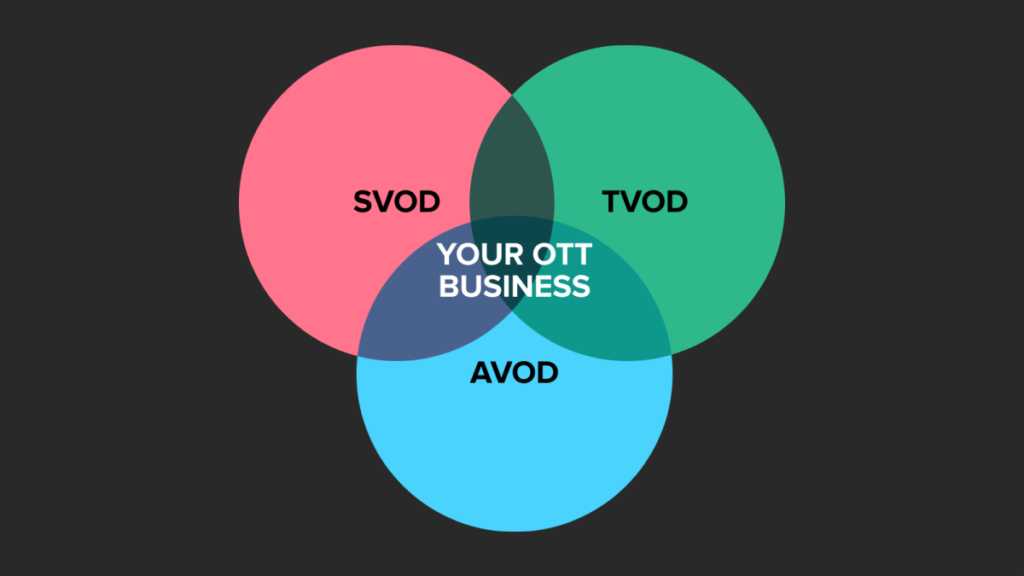OTT Industry Trends that Shaped Video Streaming in 2023
It’s proven to be a transformative year in OTT marked by rapid changes and dynamic shifts. From the widespread adoption of FAST channels to the increasing prominence of hybrid monetisation models and the transformative role of artificial intelligence (AI), the industry is witnessing a paradigm shift that will undoubtedly demand adaptation from both service providers and content creators in 2024 and onwards.
Here are our 5 noteworthy OTT industry trends and key takeaways from 2023, that are worth watching next year:
The FAST Lane to Success
The adoption of Free Ad-Supported Television (FAST) channels has continued to rise in 2023, in response to escalating churn rates. Service providers are leveraging these channels to avoid compromising revenue and retain subscribers who have become more discerning about where they invest their entertainment budgets. The significance of this trend suggests a shift in how streaming services engage with their audience, laying the groundwork for a more sustainable future.
Hybrid Monetisation Models for Sustainability
In response to the intensifying competition and the need to win back subscribers, hybrid monetisation is also becoming increasingly popular. Service providers are strategically integrating ad-supported sections into their platforms to enhance accessibility while ensuring sustainability. Even industry giant Netflix is actively exploring this avenue, underscoring the importance of striking a balance between user experience and financial viability.
TV Taking Back the Spotlight
In a surprising turn of events, the television could be on track to reclaim its throne as the primary screen for content consumption. Notably, nearly half of YouTube’s viewership now occurs on TV screens according to internal figures. This shift has profound implications for streaming providers, emphasizing the critical need for smart TV app development to secure long-term growth.
Global Expansion with Localized Cultural Content
As streaming services expand their global footprint, the demand for localised content is experiencing a surge. Viewers are increasingly seeking content that resonates with their culture, language, and preferences. This demand for diversity and inclusion is driving more and more streaming platforms to tailor their content libraries to cater to the unique tastes of different markets.
AI Transforming the OTT Experience
Undoubtedly, one of the most significant OTT industry trends of the past year is the integration of artificial intelligence into streaming. AI is not just enhancing content recommendations for users but is also expected to play a pivotal role in dynamic content creation. This enables the delivery of personalised and engaging content, keeping viewers hooked and satisfied.
In 2024, the OTT video streaming industry is poised to firmly establish and fortify these trends, promising a substantial enhancement in overall industry performance. As we navigate this evolving landscape, it becomes increasingly clear that adaptability and innovation are the cornerstones for success in this dynamic and fiercely competitive market. Streaming services must be agile in meeting evolving user expectations.
For Magine Pro, this necessitates a commitment to ongoing innovation and a steadfast focus on our OTT platform and products. By doing so, we aim to deliver optimal solutions for our customers, empowering them to seamlessly deliver their content to audiences worldwide. And ensure our clients stay ahead in an environment where meeting and exceeding user expectations is paramount.
______________________________________________________________________________________
Keen to learn more about the top OTT industry trends and how Magine Pro are navigating the changes? Get in touch with our team.
Discover more about our flexible OTT platform and how we enable our customers to monetise their live events, linear and VOD content. Visit our blog for additional insights and download our free white papers and ebooks.
Global TV: A thing of the future?
Johan Cruyff died in March, and for the three of you who don’t know who he was, this guy was a handsome, floppy-haired footballer from Holland, who transformed sport, television and the Dutch in the seventies.
He appealed to radically chic daughters and seventies-meek mums in much the same way Bowie did, or in the same way someone like that would do now; if there were anyone like that. He was one of the first global TV products and yet remained as slim, elegant and local to the proud Dutch as a tulip.
By speaking his mind – whatever came into it – he innovated constantly and challenged ideas just as often. But he was also pretty interested in making money out of his art, believing that the local baker in Barcelona, where he lived happily and died, would not give him free bread when he was 65 just because his name was Johan Cruyff. His universal appeal meant that people across Europe wanted to see him play every week and wanted to hear him give authority a clip round the ears every time he met a journalist. It helped in no small measure that he was a genius, and when he turned football into a global product by playing for the New York Cosmos, at a time when television couldn’t distribute global products, it was just another example of him seeing the future before it came. As he said at the time, “I only seem fast because I start running slightly earlier than everyone else”.
The Premier League didn’t have a Cruyff in the nineties but in one way at least it has been even more successful. They went about building the biggest worldwide show on offer through a tidy combination of velvet-green HD pitches, a clever historic ‘home of football’ brand, and a dose of piping hot stadium atmosphere. Where Cruyff was just playing how he saw it, speaking how he felt, and wearing a dashing orange kit, the EPL were completely rewriting the rules of live television without even mentioning the football. And they took the result everywhere, flooding that same ‘home of football’ with more revenues (and visitors) than the BBC, ITV, Channel 4 and Sky combined. The EPL is now truly global and wondering how it can stop people like pub landlady Karen Murphy from challenging its right to license football rights country by country by using a Greek decoder to show the Premier League in Portsmouth. Or even, if it needs to stop her.
So television has already gone global through what we should call the ‘viewer pull’ of a charismatic rebel and the ‘content push’ of marketing masterminds.
At the same time, there’s another spin to global television afforded by technology, which doesn’t have the same ‘James Bond villain’ ring to it. How about just making it easy to watch the programmes you want to watch wherever you are, for no better reason than the fact that you’ve paid for them? Or, helping a TV producer distribute a quality series that got a 35% viewing share at home but didn’t get any international buyers because it was up against a €25M blockbuster hit like The Night Manager. It could even be because the series was made in German and nobody fancied footing the subtitling bill. Or, because there’s an elusive insurance policy which TV Execs look for in an acquisition and which can be summed up as, “If I buy this and it fails, I won’t get sacked because everyone else has bought it”.
Or, how about giving a content producer the tools to target, track and monetize any programme they distribute, anywhere in the world? Audiences everywhere paying just enough to keep the cameras rolling and the storytellers telling, but not too much to make them turn to, or return to piracy.
These are the challenges that OTT was made for. Help out the viewers as they try and make TV theirs again, make watching a programme almost unethically easy, keep the revenues flowing back to the programme-makers so they can stay creative, and lastly, give some kind of human meaning to pat corporate phrases like global TV. What worldwide television ought to mean, outside its legitimate need to get paid for its programming, is that back in the day, anyone would have been able to follow Johan Cruyff any day of the week and twice on Sundays. But only if they were interested in doing that.
Image Credit: Johan Cruyff in 1987 by Rob Bogaerts (ANEFO). Image Rights.
It’s TV’s time – Finally
It is an incredible time to be a part of Magine. We are finally experiencing the opening up of the information age for live television, which means we are now able to serve the generations that have been formed by it.
The magic of genius storytelling, live performance and high quality crafted production is now consumable uninterrupted, from anywhere, in any flavor, to wherever. And it is happening fast.
Until recently, two fundamental barriers have been in the way. The first being the basic delivery mechanism, which couldn’t support the viewer letting go and getting lost in a riveting drama, or entering a mental stadium for the tense final minutes of their team’s season, without the risk of things breaking down – disaster. Viewing online or on the phone has always been a nervous high-wire walk, resorted to only in emergencies or for lower value nibbles, never glorious TV feasting.
That has all changed. You can now be brought to tears, or to your feet by staring at a phone.
The second barrier has been availability; finding something we want to dive into and watch, no matter where we are. The content we wanted to view, has often been restricted by something mysterious going on backstage – the rights paradigm.
And rightfully so – bloody good thing. Blowing up the control over where, when and by who access to the best entertainment in the world is granted would mean less to view, not more. It would mean punishing, possibly crushing the creative source of what moves us most.
This is the industry’s high-wire act. How do we gently move from localized, controlled provisioning to opening up to discovery of all the world’s greatest TV?
This too is happening. In fact, the biggest moves are being made by those with the least to lose. Those still dependent on the local model now need to embrace experiments for new audiences – there is more to gain if we move together smartly. But we have to move.
Magine at its core is a wild mix of brilliant engineers and designers, of responsible content and rights experts, and of digital business pioneers. We are all working on the same thing; sometimes boldly bounding, sometimes carefully stepping into the deep end of TV’s Time. Right now we’re working on developing what we call the TV Superhighway, the new partnership playing field for viewers, creators and entrepreneurs to all win together in the new arena.
Game on.





